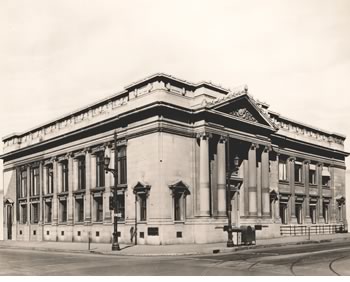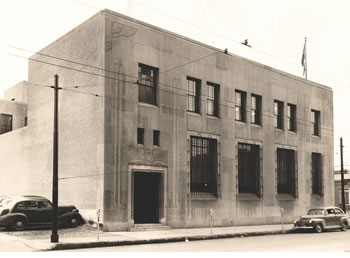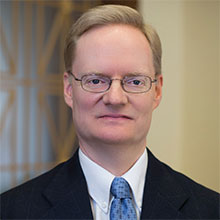Reaching Our Constituents
To Better Serve the Eighth District, the St. Louis Fed Established Three Branches
Today, Louisville, Ky., Memphis, Tenn., and Little Rock, Ark.—the St. Louis Fed's branch city locations—are known for their leadership in such areas as logistics and shipping, health care and medical research, music and other entertainment. A hundred years ago, they were better known for gristmills, cotton exchanges and lumber. Then, and now, these three cities were the economic powerhouses of their regions. They were also banking centers; in fact, two of the three were in the running for a Federal Reserve bank.
The branches in all three cities started operations soon after the Federal Reserve Bank of St. Louis opened for business in 1914: Louisville opened its doors in 1917, Memphis in 1918 and Little Rock in 1919. (For a look at what the branches are doing today, see the essay "St. Louis Fed Branch Offices.") What follows is a little history on why these cities were chosen as branches.
Louisville, Ky.
History and Economy

The Louisville Branch of the St. Louis Fed was located in this building at the corner of Fifth and Market streets in the 1920s.
The population, industrial base and banking industry of Louisville all grew rapidly in the years following the Civil War, especially toward the end of the 19th century and the beginning of the 20th century. The city's population increased by more than five times between 1890 and 1914, from 43,194 to 235,114. This expansive growth spurred business and residential development within the city: apartment buildings, skyscrapers and the trappings of modern life.See Yater, pp. xxii-xxiii.
The growth of Louisville's manufacturing sector was also explosive. Between 1899 and 1909, the real (inflation-adjusted) value of manufactured product in Louisville rose 25 percent. Although growth subsequently slowed, the total employment and output of the city's manufacturing firms exceeded those of all other Kentucky cities in 1914. In that year, Louisville firms produced 46 percent of the state's industrial output. The city's leading industries included distilled liquor, railroad repair, ground flour and grains, metals and machinery, and printing and publishing.Preceding two paragraphs are from Sandmeyer, "Kentucky."
Banking
As in much of the nation, banking was volatile in Louisville during the 19th century, which saw numerous bank failures and general banking instability. Despite these difficulties, the city was a leading regional banking center. Louisville boasted the first national bank south of the Ohio River, and its bank clearinghouse was established immediately following the Civil War.
In the years that followed, Louisville's banking industry continued to expand. By 1889, 22 banks, including 10 national banks, were located within the city's limits. Louisville's banks provided much of the capital that was used to develop the city's industrial base and burgeoning livestock industry, as well as to finance the construction of railroads and bridges.See McCabe, pp. 59-60. When the Reserve Bank Organization Committee (RBOC) surveyed national banks for their preferred locations for Federal Reserve banks, 73 percent of banks in Kentucky selected Louisville as their first choice.See United States. Reserve Bank Organization Committee, 1914, Location of Reserve Districts in the United States, p. 353.
Louisville was among 37 U.S. cities to petition the RBOC to be chosen as the headquarters of a Federal Reserve district. The city's boosters argued that Louisville's location and industrial and commercial prominence made it well-situated to serve the interests of both its region and the nation. In its argument before the committee, Louisville left no room for concession: "We have not seriously considered Louisville being attached to some other reserve city. To attach it to Atlanta would be to attach the greater to the lesser, the independent to the dependent, to reverse the natural order of things, to violate precedent, and therefore it is not seriously to be considered."See United States. Reserve Bank Organization Committee, 1914, Box 2654, Folder 1: Arguments in Behalf of Louisville as a Federal Reserve City, p. 9.
The RBOC did not choose Louisville for a Reserve bank. Instead, the city and the western portion of Kentucky were placed in the Eighth Federal Reserve District, headquartered in St. Louis. In 1916, Louisville's representatives petitioned the Federal Reserve Board for a branch office of the St. Louis Fed, arguing that large amounts of bank deposits were being diverted away from their city to St. Louis, thereby degrading the integrity and strength of banks in Louisville. Importantly, Louisville bankers argued that a local branch was needed to properly administer and discount the whiskey and tobacco paper, which was in widespread use throughout the region.See Federal Reserve System Board of Governors, pp. 8-10.
A few St. Louis bankers opposed the establishment of a Fed branch in Louisville. Louisville's regional importance and national prominence, however, made it nearly inevitable that a branch would be opened in the city. On Dec. 3, 1917, the first branch of the Federal Reserve Bank of St. Louis was opened in Louisville. Two years later, the Branch had 53 employees and served 95 member banks.See annual reports of the Federal Reserve Bank of St. Louis from 1917 through 1919 at https://fraser.stlouisfed.org/publication/?pid=149.
Memphis, Tenn.
History and Economy

This building at Jefferson Avenue and Third Street (seen here in 1943) housed the Memphis Branch from 1929 to 1972.
Located on the fourth Chickasaw Bluff along the Mississippi River, Memphis has served as a hub for commerce and trade regionally, nationally and internationally throughout most of its history. Like Louisville, Memphis developed rapidly in the late 19th century, diversifying its economy and investing heavily in infrastructure improvements.See James and Young, p. 213. The city's population grew rapidly, from 33,592 in 1880 to 64,495 in 1890 to 102,320 in 1900. By 1914, Memphis' population was estimated to be 143,231, making it the largest city in the state of Tennessee.Compiled from “Area, Natural Resources, and Population,” in Statistical Abstract of the United States of 1914 (U.S. Bureau of Foreign and Domestic Commerce), Table 29, pp. 42-43.
At the turn of the 20th century, the cotton trade was the dominant business in Memphis. Founded in 1873 in response to the formation of cotton exchanges in New York City and New Orleans, the Memphis Cotton Exchange grew to international importance.See Wrenn. According to the Annual Statement of Trade and Commerce of Memphis, in 1913 the city had the largest inland cotton market in the world, with receipts for some 1 million bales of cotton. In that year, Memphis also reportedly had the world's largest hardwood lumber market.See Memphis Merchants Exchange, pp. 22-23.
In addition to its cotton and lumber markets, Memphis had a developing manufacturing sector. Between 1909 and 1914, the city's manufacturing output grew by 29 percent, led primarily by the production of oil and cottonseed products, tobacco goods and food preparations.See Webb. In 1914, the industrial output of Memphis exceeded that of all other Tennessee cities.
Banking
Memphis' first bank opened in 1834. Like many cities, Memphis faced episodic banking instability throughout the 19th century. A nationwide banking panic in 1873, which coincided with a yellow fever epidemic in the South, nearly brought down all of Memphis' banks. However, not a single Memphis bank failed when another panic struck in 1893. Memphis' banks were heavily involved in the financing of cotton agriculture, but also helped to finance the city's economic diversification and growth at the turn of the 20th century.See James and Young, pp. 579-83. In 1913, the year the Federal Reserve Act was passed, there were 27 banks operating in Memphis, including three national banks.Memphis Merchants Exchange, p. 38. However, the RBOC’s Location of Reserve Districts in the United States (Table F) reports that there were 22 banks in Memphis.
Memphis was also one of 37 U.S. cities that petitioned the RBOC for a Reserve bank. Memphis saw itself as having the amenities to meet the region's economic needs: within 300 miles of 13 states, a well-developed mail service, access to the Mississippi River for transportation and trade, and 17 rail lines connecting it to the rest of the country.See United States. Reserve Bank Organization Committee, 1914. Location of Reserve Districts in the United States, pp. 205-08.
Whereas Memphis was the largest city in Tennessee and ranked first in manufacturing output, the city was not the first choice for the location of a Reserve bank among many Tennessee bankers. In the RBOC survey of national banks about their preferred location for a Reserve bank, Memphis received fewer first- and second-place votes than did Chattanooga and Nashville—sister cities in Tennessee. Ultimately, the RBOC placed Memphis, along with the western part of Tennessee, in the Eighth Federal Reserve District, headquartered in St. Louis. The St. Louis Fed soon opened a seasonal office in Memphis to provide discount window loans and other services to area member banks during the cotton season. The Memphis office was upgraded to a full-service branch in 1918. By the end of 1919, the Memphis Branch had 68 employees and served 42 member banks.See annual reports of the Federal Reserve Bank of St. Louis from 1917 through 1919 at https://fraser.stlouisfed.org/publication/?pid=149.
Little Rock, Ark.
History and Economy
Because of its location along the Arkansas River and close proximity to the center of the state, Little Rock was well-situated as the Arkansas state capital and as the state's economic leader. In 1914, Little Rock was the only Arkansas city with more than 50,000 residents, accounting for 3 percent of the state's population.Compiled from “Cities Having 50,000 or More Inhabitants in 1914: Population at Each Census, 1850 to 1910, with Estimates for July 1, 1914,” in Statistical Abstract of the United States of 1914 (U.S. Bureau of Foreign and Domestic Commerce), Table 29, pp. 42-43.
Little Rock grew rapidly during the early 20th century, doubling in size between 1890 and 1914, including 17 percent between 1909 and 1914. Construction activity was brisk: The city's first skyscraper (1907), the Arkansas Capitol (1899-1914) and the municipal airport (1917) were all constructed during these first two decades.See Bell. Though small in stature, Little Rock was a city on the rise.
The leading industries of Little Rock in the early 20th century were lumber, cottonseed, and printing and publishing. Lumber production and allied products employed 39 percent of the Little Rock manufacturing labor force and comprised 28 percent of the city's total manufacturing output.See Sandmeyer, “Arkansas.” Table 31.
Banking
According to University of Arkansas historian John Dominick, Arkansas state banks were chartered at an "alarming rate" in the late 19th and early 20th centuries. The number of banks increased from 83 in 1891 to a peak of 425 in 1914. This haphazard growth brought with it a series of bank failures, which, in Dominick's estimation, occurred primarily as a result of an oversaturated market, low capital requirements and poor bank management. State legislators saw a need for more regulation. In 1913, they passed legislation establishing a state bank department to regulate bank operations and institute a more stable foundation from which the banking industry could flourish.See Dominick.
While clearly the most important city in Arkansas, Little Rock was not seen as a national center for banking and finance. In the RBOC's survey of national banks about their preferences for the locations of Reserve banks, Little Rock received no first-choice votes, one second-choice vote and just two third-choice votes. The majority of the state's national banks listed St. Louis or Kansas City as their first choice.See United States. Reserve Bank Organization Committee, 1914. Location of Reserve Districts in the United States, p. 351.
The RBOC placed Little Rock, along with the entire state of Arkansas, in the Eighth Federal Reserve District, headquartered in St. Louis. In 1918, the Federal Reserve Board granted a petition to establish a branch of the Federal Reserve Bank of St. Louis in Little Rock. The Little Rock Branch opened Jan. 6, 1919. By the end of the year, the Branch had 38 employees and served 57 area member banks.See annual reports of the Federal Reserve Bank of St. Louis from 1917 through 1919 at https://fraser.stlouisfed.org/publication/?pid=149.
Notes
- See Yater, pp. xxii-xxiii.
- Preceding two paragraphs are from Sandmeyer, "Kentucky."
- See McCabe, pp. 59-60.
- See United States. Reserve Bank Organization Committee, 1914, Location of Reserve Districts in the United States, p. 353.
- See United States. Reserve Bank Organization Committee, 1914, Box 2654, Folder 1: Arguments in Behalf of Louisville as a Federal Reserve City, p. 9.
- See Federal Reserve System Board of Governors, pp. 8-10.
- See annual reports of the Federal Reserve Bank of St. Louis from 1917 through 1919 at https://fraser.stlouisfed.org/publication/?pid=149.
- See James and Young, p. 213.
- Compiled from "Area, Natural Resources, and Population," in Statistical Abstract of the United States of 1914 (U.S. Bureau of Foreign and Domestic Commerce), Table 29, pp. 42-43.
- See Wrenn.
- See Memphis Merchants Exchange, pp. 22-23.
- See Webb.
- See James and Young, pp. 579-83
- Memphis Merchants Exchange, p. 38. However, the RBOC's Location of Reserve Districts in the United States (Table F) reports that there were 22 banks in Memphis.
- See United States. Reserve Bank Organization Committee, 1914. Location of Reserve Districts in the United States, pp. 205-08.
- See annual reports of the Federal Reserve Bank of St. Louis from 1917 through 1919 at https://fraser.stlouisfed.org/publication/?pid=149.
- Compiled from "Cities Having 50,000 or More Inhabitants in 1914: Population at Each Census, 1850 to 1910, with Estimates for July 1, 1914," in Statistical Abstract of the United States of 1914 (U.S. Bureau of Foreign and Domestic Commerce), Table 29, pp. 42-43.
- See Bell.
- See Sandmeyer, "Arkansas." Table 31.
- See Dominick.
- See United States. Reserve Bank Organization Committee, 1914. Location of Reserve Districts in the United States, p. 351.
- See annual reports of the Federal Reserve Bank of St. Louis from 1917 through 1919 at https://fraser.stlouisfed.org/publication/?pid=149.
References
Bell, James W. "Little Rock (Pulaski County)," in The Encyclopedia of Arkansas History and Culture, 2013. See www.encyclopediaofarkansas.net/encyclopedia/entry-detail.aspx?entryID=970.
Dominick, John. "Banking," in The Encycopedia of Arkansas History and Culture, 2009. See www.encyclopediaofarkansas.net/encyclopedia/entry-detail.aspx?entryID=5000.
Federal Reserve System Board of Governors. 1916, Hearing Before the Federal Reserve Board on Behalf of the City of Louisville, Petitioning for a Branch Federal Reserve Bank of the St. Louis Reserve District. See https://fraser.stlouisfed.org/publication-series/?id=488.
James, A.R.; and Young, J.P. Standard History of Memphis: From a Study of the Original Sources (Knoxville: H.W. Crew & Co., 1912). This history of the city of Memphis provides the reader with not only the historical development of this major southern city, but also a glimpse into the way Memphians regarded themselves in view of both their history and future in the early 20th century.
McCabe, James. R. "Banking." In The Encyclopedia of Louisville, ed. John E. Kleber (Lexington: The University Press of Kentucky, 2001), pp. 59-63.
Memphis Merchants Exchange. Annual Statement of Trade and Commerce of Memphis, Tennessee, for the Year Nineteen Hundred and Twelve. Memphis: Memphis Merchants Exchange, 1913. Available in google.com/books by searching the title.
Sandmeyer, Henry W. "Arkansas," in U.S. Census of Manufactures, 1914: Vol. II, Reports by States with Statistics for Principal Cities and Metropolitan Districts. Washington, D.C.: Government Printing Office, 1918, pp. 777-817.
Sandmeyer, Henry W. "Kentucky," in U.S. Census of Manufactures, 1914: Vol. II, Reports by States with Statistics for Principal Cities and Metropolitan Districts. Washington, D.C.: Government Printing Office, 1918, pp. 473-97.
United States. Reserve Bank Organization Committee, 1914, Box 2654, Folder 1: Arguments in Behalf of Louisville as a Federal Reserve City, from Records of the Federal Reserve System. See https://fraser.stlouisfed.org/docs/historical/nara/nara_rg082_e02_b2654_04.pdf.
United States. Reserve Bank Organization Committee, 1914, Location of Reserve Districts in the United States. See https://fraser.stlouisfed.org/publication/?pid=606.
Webb, Martin T. "Tennessee," in U.S. Census of Manufactures, 1914: Vol. II, Reports by States with Statistics for Principal Cities and Metropolitan Districts. Washington, D.C.: Government Printing Office, 1918, pp. 777-817.
Wrenn, Lynette Boney. "Memphis Cotton Exchange," in The Tennessee Encyclopedia of History and Culture, version 2.0, 2011. See https://tennesseeencyclopedia.net/entry.php?rec=893.
Yater, George H. "Louisville: A Historical Overview," in The Encyclopedia of Louisville, ed. John E. Kleber (Lexington: The University Press of Kentucky, 2001), pp. xv-xxxi.



